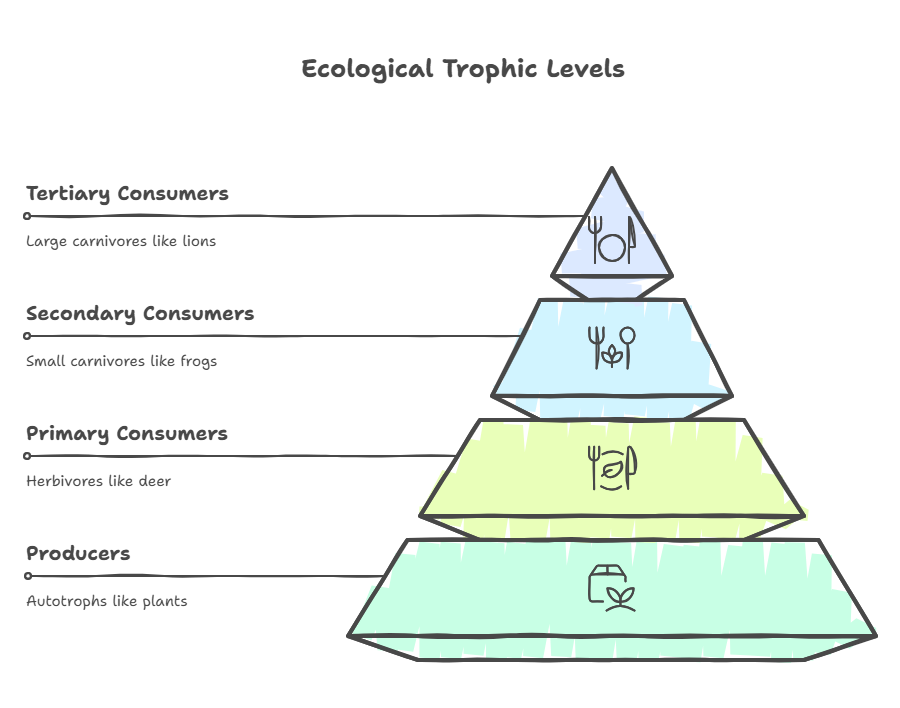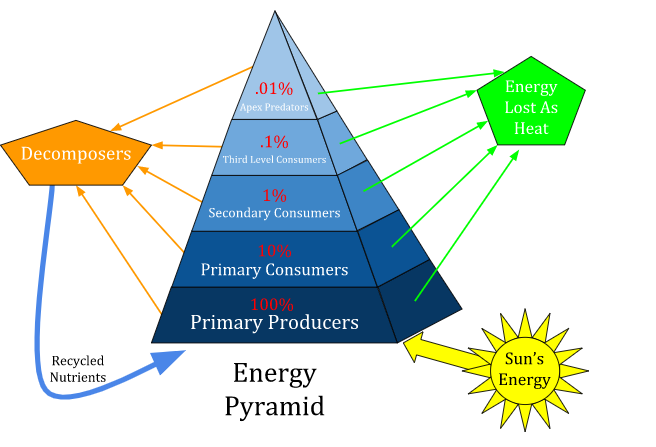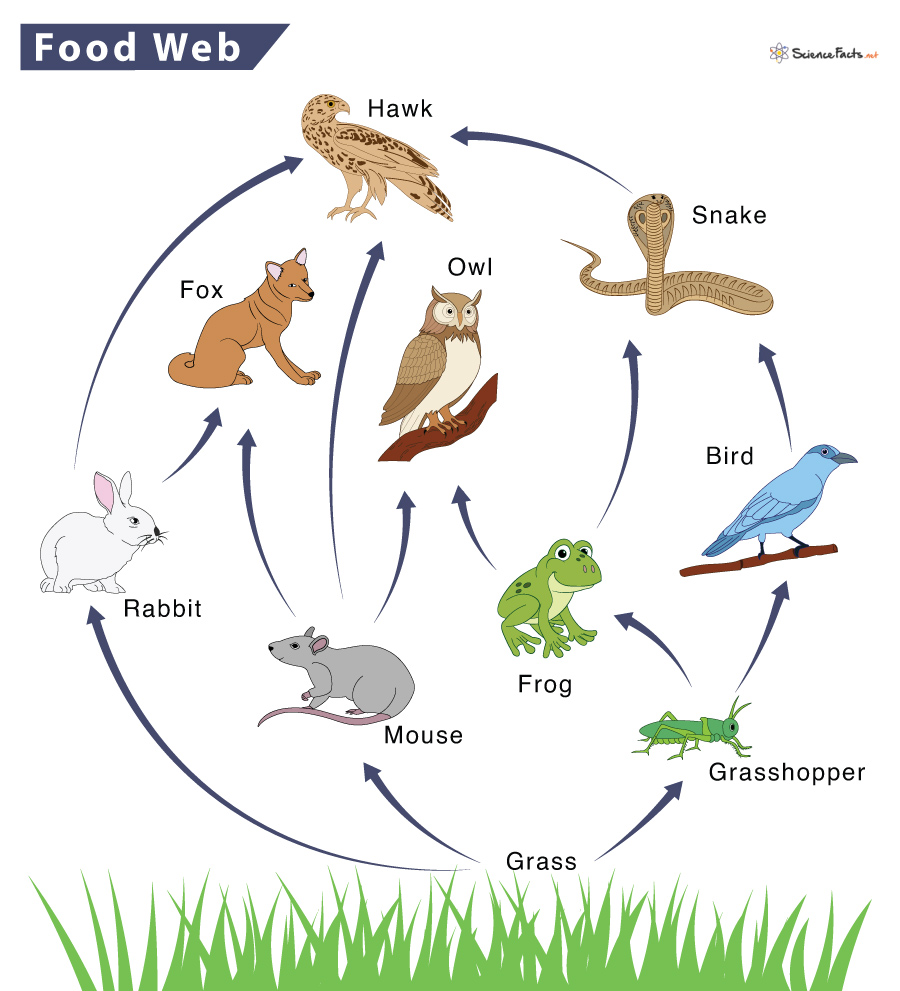Chapter 13: Our Environment
Our Environment
Introduction
- The environment encompasses all living and non-living components interacting in a given area, maintaining a natural balance.
- This chapter explores ecosystems, their components, energy flow, food chains, and human impacts like ozone depletion and waste management.
- Understanding environmental interactions is crucial for sustainable living.
13.1 Eco-System – What Are Its Components?
- Ecosystem: A system of interacting organisms (biotic) and physical surroundings (abiotic) in an area, maintaining balance.
- Components:
- Biotic: Living organisms (plants, animals, microorganisms, humans).
- Abiotic: Non-living factors (temperature, rainfall, wind, soil, minerals).
- Examples:
- Natural Ecosystems: Forests, ponds, lakes.
- Artificial Ecosystems: Gardens, crop fields, aquariums.
- Activity 13.1:
- Design an aquarium: Requires space (jar), water, oxygen (aerator), food.
- Add aquatic plants/animals for a self-sustaining system (plants produce oxygen, animals consume plants).
- Aquariums need periodic cleaning to remove waste; natural ponds/lakes are self-cleaned by decomposers and water flow.
- Organism Roles:
- Producers: Green plants, some bacteria; use sunlight and chlorophyll to produce food (e.g., sugars, starch) via photosynthesis.
- Consumers: Depend on producers directly/indirectly.
- Herbivores: Eat plants (e.g., deer, rabbit).
- Carnivores: Eat animals (e.g., lion, eagle).
- Omnivores: Eat both (e.g., human, bear).
- Parasites: Live on/in hosts (e.g., lice, tapeworm).
- Decomposers: Bacteria, fungi; break down dead organisms/waste into simple inorganic substances for soil replenishment.
- Activity 13.2:
- Avoid predatory aquatic animals in aquariums to prevent ecosystem collapse.
- Discuss organism interdependence: Producers support consumers; consumers provide nutrients via waste; decomposers recycle nutrients.
- Example food chain: Algae → Small fish → Large fish.
- Primary importance: Producers (base of food chain, energy source); all groups are critical for balance.
- Ecosystems rely on interdependent biotic and abiotic components for stability.
13.1.1 Food Chains and Webs
- Food Chain: Series of organisms where each feeds on the previous one, forming trophic levels (Fig. 13.1).
- Trophic Levels (Fig. 13.2):
- 1st: Producers (autotrophs, e.g., plants).
- 2nd: Primary consumers (herbivores, e.g., deer).
- 3rd: Secondary consumers (small carnivores, e.g., frogs).
- 4th: Tertiary consumers (large carnivores, e.g., lions).
- Energy Flow (Fig. 13.4):
- Unidirectional: From sun to producers to consumers to decomposers.
- Producers capture ~1% of sunlight energy, converting it to chemical energy.
- At each trophic level, ~10% of energy is transferred to the next (rest lost as heat, used in digestion/work).
- Energy loss limits food chains to 3–4 steps.
- Food Web: Network of interconnected food chains; each organism may be eaten by multiple others (Fig. 13.3).
- Biological Magnification:
- Non-degradable chemicals (e.g., pesticides) accumulate in organisms, increasing in concentration up the food chain.
- Humans (top trophic level) accumulate the highest concentrations, leading to health risks.
- Activity 13.3:
- Debate pesticide bans in food items; sources include crops treated with pesticides, absorbed by plants or aquatic organisms.
- Reduce intake: Wash produce, choose organic foods, support stricter regulations.
- Questions:
- Trophic Levels:
- Steps in a food chain; Example: Grass → Deer → Lion.
- Levels: Grass (producer, 1st), Deer (primary consumer, 2nd), Lion (secondary consumer, 3rd).
- Decomposers’ Role:
- Break down dead organisms/waste into inorganic substances, recycling nutrients for plants; prevent waste accumulation.
- Food chains and webs illustrate energy flow and chemical accumulation in ecosystems.
13.2 How Do Our Activities Affect the Environment?
- Human Impact: Our activities alter the environment, causing issues like pollution, ozone depletion, and waste accumulation.
- Human actions require careful management to minimize environmental harm.
13.2.1 Ozone Layer and How It Is Getting Depleted
- Ozone (O₃):
- Molecule of three oxygen atoms; toxic at ground level but vital in the upper atmosphere.
- Shields Earth from harmful ultraviolet (UV) radiation, which causes skin cancer and ecosystem damage.
- Formation:
- UV radiation splits O₂ into free oxygen atoms: \( \text{O}_2 \xrightarrow{\text{UV}} \text{O} + \text{O} \).
- Free oxygen combines with O₂: \( \text{O} + \text{O}_2 \rightarrow \text{O}_3 \).
- Depletion:
- Sharp decline since the 1980s due to chlorofluorocarbons (CFCs) used in refrigerants and fire extinguishers.
- CFCs release chlorine, which breaks down ozone molecules.
- Action Taken:
- 1987 UNEP agreement (Montreal Protocol) froze CFC production at 1986 levels.
- Mandatory CFC-free refrigerators globally.
- Activity 13.4:
- Research chemicals (e.g., CFCs, halons) causing ozone depletion.
- Evaluate regulations’ success; recent data shows reduced ozone hole size due to CFC bans.
- Ozone protection is critical for life, with global efforts reducing depletion.
13.2.2 Managing the Garbage We Produce
- Waste Generation:
- Daily waste includes kitchen waste, paper, plastics, clothes, footwear.
- Increased by lifestyle changes, disposable products, and non-biodegradable packaging.
- Biodegradable vs. Non-Biodegradable:
- Biodegradable: Broken down by biological processes (e.g., food, paper).
- Non-Biodegradable: Persist in environment (e.g., plastics, metals); broken down only by physical processes (heat, pressure).
- Activity 13.5:
- Bury household waste under 15 cm soil; observe at 15-day intervals.
- Biodegradable (e.g., food, paper) decomposes; non-biodegradable (e.g., plastics) persists.
- Food waste decomposes fastest.
- Activity 13.6:
- Research biodegradable (e.g., organic matter) and non-biodegradable (e.g., plastics, lifetime: 100–1000 years) substances.
- Biodegradable plastics exist but may still harm environment during production/decomposition.
- Activity 13.7:
- Investigate household/classroom waste: Quantity, biodegradability.
- Check local waste collection/treatment systems for separate biodegradable/non-biodegradable handling.
- Solutions: Composting, recycling, reducing single-use items.
- Activity 13.8:
- Study local sewage treatment to prevent water pollution.
- Investigate industrial waste treatment to avoid soil/water contamination.
- Activity 13.9:
- E-waste contains hazardous materials (e.g., lead, mercury), harming soil/water if not properly disposed.
- Plastic recycling reduces waste but may release pollutants during processing.
- Disposable Cups Case Study:
- Plastic cups replaced reusable glasses for hygiene but caused waste accumulation.
- Kulhads (clay cups) deplete fertile soil; paper cups are biodegradable, reducing environmental impact.
- Questions:
- Biodegradable vs. Non-Biodegradable:
- Biodegradable substances are broken down by specific enzymes/microorganisms; non-biodegradable lack such pathways, persisting in environment.
- Biodegradable Impact:
- Nutrient recycling supports plant growth; improper disposal (e.g., food waste) attracts pests.
- Non-Biodegradable Impact:
- Pollutes soil/water, harms wildlife (e.g., plastic ingestion), accumulates in environment.
- Effective waste management is essential to mitigate environmental degradation.
Key Questions and Answers
- Ozone and Ecosystem Impact:
- Ozone (O₃) in upper atmosphere shields UV radiation; depletion increases UV exposure, causing skin cancer and ecosystem damage.
- Reducing Waste Disposal Problems:
- Recycle materials (e.g., paper, plastics); compost biodegradable waste.
- Biodegradable Items:
- (a) Grass, flowers, leather; (c) Fruit-peels, cake, lime-juice; (d) Cake, wood, grass are biodegradable. Answer: (a), (c), (d).
- Food Chain:
- (b) Grass → Goat → Human represents a food chain. Answer: (b).
- Environment-Friendly Practices:
- All listed practices (cloth bags, switching off lights, walking) reduce environmental impact. Answer: (d).
- Killing All Organisms in a Trophic Level:
- Disrupts food chain; e.g., no producers stop energy flow, collapsing ecosystem.
- Impact of Removing Trophic Levels:
- Impact varies: Removing producers is most disruptive (no energy input); removing higher levels affects fewer organisms but alters balance.
- No level can be removed without damage due to interdependence.
- Biological Magnification:
- Accumulation of non-degradable chemicals up food chain; higher trophic levels (e.g., humans) have greater concentrations, increasing toxicity risks.
- Non-Biodegradable Waste Problems:
- Pollution, wildlife harm, long-term environmental persistence.
- All Biodegradable Waste:
- Still impacts environment if mismanaged (e.g., methane from decomposing waste, pest attraction).
- Ozone Layer Damage Concerns:
- Increased UV radiation harms health and ecosystems.
- Steps: Montreal Protocol (CFC bans), promoting CFC-free products.


